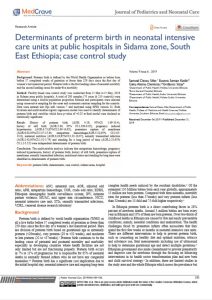
Background
Preterm birth is defined by the World Health Organization as babies born before 37 completed weeks of gestation or fewer than 259 days since the first day of woman’s last menstrual period. Preterm birth is the first leading cause of neonatal mortality and the second leading cause for under-five mortality.
Method
Facility-based case control study was conducted from 1st Mar to 1st May, 2018 in Sidama zone public hospitals. A total of 280 samples (70 cases & 210 controls) were determined using a double population proportion formula and participants were selected using consecutive sampling for the cases and systematic random sampling for the controls. Data were entered into Epi info version 7 and analyzed using SPSS version 23. Both bivariate and multivariable logistic regression model was used to identify determinants of preterm birth and variables which have p-value of <0.05 at final model were declared as statistically significant.
Result
History of preterm birth (AOR: 4.19; 95%CI: 1.69-10.4), history of still birth (AOR:3.66; 95% CI:1.389-9.65), pregnancy induced hypertension (AOR:6.73;95%CI:2.69-16.85), premature rupture of membrane (AOR:6.92;95%CI:3.07-15.64, antepartum hemorrhage(AOR:5.52;95% CI:2.0514.8), maternal nutrition (AOR:6.26;95%CI:2.32-16.87], sexually transmitted infection (AOR:2.42;95%CI:1.01-5.79) and standing for a long period of time (AOR:2.53;95% CI:1.2-5.35) were independent determinants of preterm birth.
Conclusion
The multivariable analysis indicate that antepartum hemorrhage, pregnancy induced hypertension, history of preterm birth, history of still birth, premature rupture of membrane, sexually transmitted infection, nutritional status and standing for long time were identified as determinants of preterm birth.